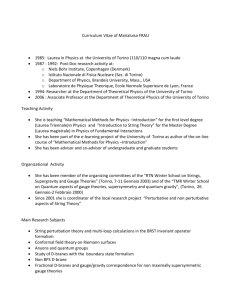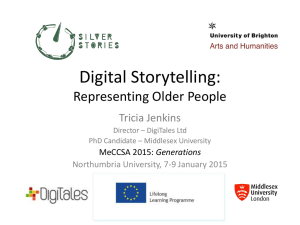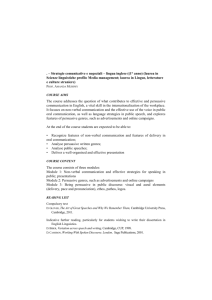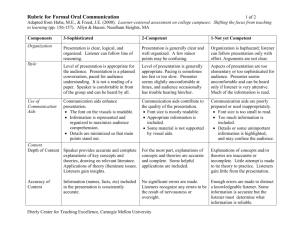Making Oral Presentations - Viestintäpiste Laurea Leppävaara
advertisement
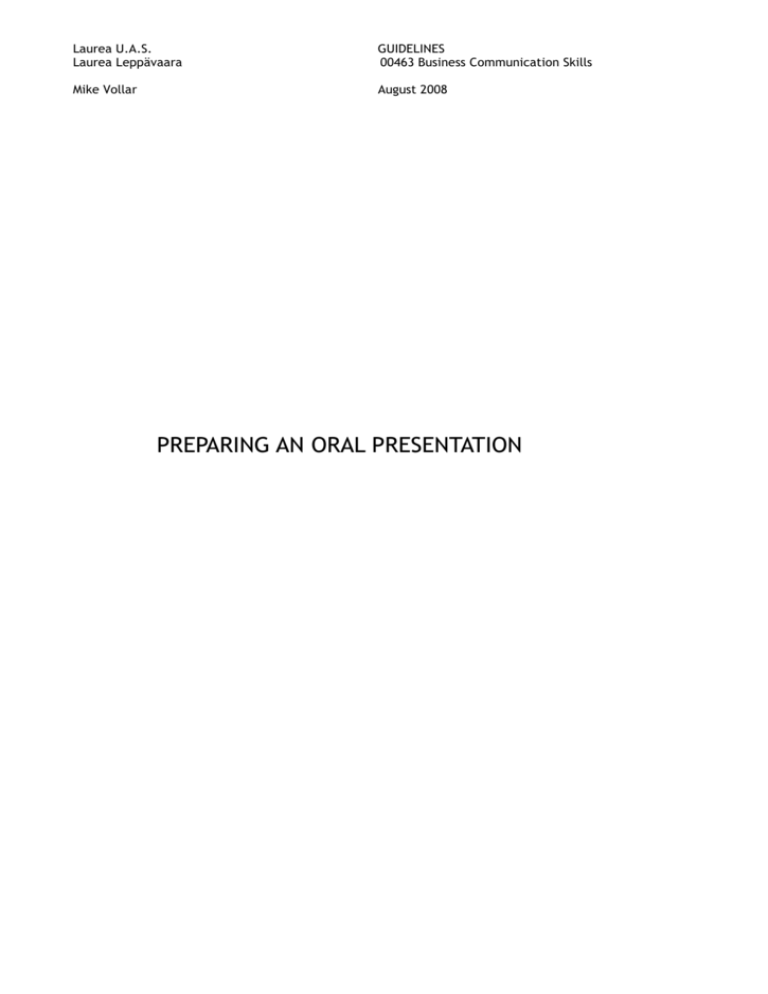
Laurea U.A.S. Laurea Leppävaara GUIDELINES 00463 Business Communication Skills Mike Vollar August 2008 PREPARING AN ORAL PRESENTATION Laurea U.A.S. Laurea Leppävaara GUIDELINES 00463 Business Communication Skills Mike Vollar August 2008 PREPARING AN ORAL PRESENTATION 1. Introduction A common mistake is to “jump” straight into a presentation at high speed without giving the audience adequate preparation for what’s coming, and before they get used to the fact that a new person is standing in front of them with a new subject. So try to begin confidently and clearly without rushing. Don’t get down to solid facts before you’re sure that you’ve got your audience’s attention, and that they have some kind of picture of what to expect in the next 10 minutes or so. Typically, the introductory section of your talk will include the following 3 elements: a brief explanation of who you are, what the subject is, and possibly why you are talking about this particular subject. a statement of the objectives of your presentation, in other words what you plan to achieve during the next 5 minutes/ half an hour/ or whatever. a brief outline of the main points you plan to cover during your talk. Be careful not to go into any more detail than is necessary at this stage. 2. Content It’s difficult to give black-and-white advice about content which would be appropriate in all situations, but careful planning is what makes a difference, especially with regard to the time frame you’ve been given. If your presentation is noticeably shorter it leaves an unsatisfactory feeling, but even worse is to go significantly over time. This shows a disrespect for your listeners, even more so if you are just rambling, wasting time without presenting much solid information at all. Audience time is valuable time. So at an early stage of your preparation you need to map out what areas you feel you need to cover, including the introduction mentioned above. As you prepare, keep an eye on the overall balance of the content and on whether there is any superfluous information - don’t be afraid to leave it out if time is short. During the preparation phase, your task is to prioritise. Check also that you are presenting your information systematically within a framework that is gradually revealed to the listeners, in other words that you progress clearly through a set of points. You need to avoid wandering around aimlessly, leaving the listener wondering Laurea U.A.S. Laurea Leppävaara GUIDELINES 00463 Business Communication Skills Mike Vollar August 2008 what the point of all this interesting information is. Partly for this reason, you need to create links (sometimes called “road-signs” or, more officially, metatext) between one small information area and the next. This is more important than in written material, where an overview of everything on the page can be taken in at a glance with possible section headings for further guidance, but in oral work there is a clear need for such bridging phrases as “Now that we understand how … works, “ or “Let me next describe how ….” or “I now want to move on to ….”. The listener needs to be given a feeling of where we are coming from and where we are going. No presentation is complete without some kind of conclusion. This doesn’t need to be anything very dramatic or significant, sometimes just a quick summary of what’s been covered will be enough, but all too often students finish a talk by working through the last main point, and then simply walking away or collapsing into embarrassed silence. You need to create a clear feeling of having now arrived at the end. 3. Language Most people when preparing a presentation rely fairly heavily on external sources such as Internet documents for the facts, information and data which they are going to present. If you simply lift the language of the original document into your presentation too, the result is almost always weak, possibly disastrous. There are two main reasons for this: the register (meaning the style or level) of the language is unsuitable for this task the language is “dead” or inexpressive, too divorced from you the presenter. So even though you’ve borrowed the information from an external source, it’s very important that you present it in your own words, and in a lively and interesting way so that it sounds and feels like you are thinking aloud. It’s almost impossible to genuinely contact an audience if you are reading a prepared script, even one you have written yourself. The only thing that really matters is the effect your words are having on the audience. As a general rule, if you’re unsure of your language skills and are afraid you might not manage, it’s important to be fully confident of the information you’re planning to present to us, and then let the words take care of themselves. They will come, even if not exactly as planned. It’s not a crime during a presentation to have to think aloud while searching for a word or how to explain something, as long as you don’t overdo it. Laurea U.A.S. Laurea Leppävaara GUIDELINES 00463 Business Communication Skills Mike Vollar August 2008 Here is a list of points to keep in mind when planning the language of your presentation. Your language doesn’t need to be perfect as it does in a written document. Instead you should concentrate on making the language interesting and alive. Use notes to guide and remind you, but never a ready-written script and never a text written by somebody else. Keep the notes as minimal as you dare, for example on Keycards. Keep the language on a level which your audience can handle, in other words don’t let it become too technical or complicated. This is an oral situation. Make sure there is some variety in your language, so not all short simple sentences, and not all heavy complicated sentences. 4. Delivery The key point in your delivery is to keep in mind how things look from the listener’s point of view. If the way you are handling things wouldn’t keep you interested either, then you’re not doing a good job. There’s no point in expecting an audience to come to a lecture hall and listen to a presentation, if you don’t offer them something more and different from what they would get by reading the text themselves at home. You therefore need to pay attention to the following factors : Volume. Most students aren’t used to speaking publicly and so speak much too quietly. Aim at somebody at the back of the room and speak loud enough that he/she can listen to you comfortably. On the other hand, bellowing is also undesirable unless your intention is to intimidate your listeners. Intonation and expression. Speakers use this to create interest and also to highlight key words and ideas. Without it a spoken text quickly becomes monotonous and the listener finds it difficult to separate ideas and phrases from each other. Typically Finns use a minimum of intonation and English people a lot, but in any case students need to practise using it as a tool for creating interest. Pauses. As with intonation, use pauses to help the listener to follow the structure of your sentences. Avoid rushing forwards at the same pace all the time. Speed. Not too fast and not too slow. Students rarely talk too slowly unless they don’t know what they are trying to say. Short phrases. In an oral presentation the listener only gets one chance to hear information, so as well as keeping an eye on the speed, you also need to keep phrases short enough to be digested and even to use repetition, for example saying the same thing twice in different ways (as I have just done!) to drive the point Laurea U.A.S. Laurea Leppävaara GUIDELINES 00463 Business Communication Skills Mike Vollar August 2008 home. This doesn’t mean that sentences need to be short. Pronunciation. This isn’t a coffee-table chat, so be sure to enunciate everything more clearly and carefully than normal, especially when you have a noticeable foreign accent in English. If at all possible, try to cut out such natural sounds as “er” and “um” and replace them with a “thinking-aloud” short phrase. 5. Body language This is something most people would prefer not to pay any attention to, or to pretend that it doesn’t really matter. It does. As with meeting people face to face, first impressions are very important. Most audiences will be very sympathetic towards a new speaker but you will find it easy to destroy this sympathy totally in about 2 minutes if your delivery and body language are wrong. The following is a list of matters which actively need attention before you arrive in front of your audience, as you might not even be aware of them yourself. Standing. Except in very special circumstances you obviously can’t give a presentation sitting down. You need to project an image of authority and confidence. Eye contact. You need to show the audience that you are interested in them and that you have something to communicate to them, so don’t keep your eyes fixed downwards or on the piece of paper in your hands. It’s often a good idea either to talk to a point at the back of the room, or to direct your words to one individual who changes fairly often so that your staring doesn’t become threatening or too personal. But keep those eyes up! Facial expression. Not too passive or you’ll look disinterested. Don’t let your face show them the truth, that you’d rather be somewhere else! And remember (especially Finns) that in Anglo culture a small smile represents a neutral attitude whereas a passive expression is already a negative comment. Personal space. Whether you like it or not, you are in control of the whole situation during your presentation, and your body language must confirm this. Come out and stand clearly in front of the group, taking care that you don’t give the impression of hiding behind a desk, projector, screen or even window curtain (I’ve actually seen this!) Define a not too extensive area at the front of the room that belongs to you, and remember to move around inside that area, but in a slow, controlled purposeful manner otherwise you’ll destroy the focus. Just don’t stand like a lamp-post in front of us! Gestures. Be careful with your hands, they tell too much about you, so try to avoid Laurea U.A.S. Laurea Leppävaara GUIDELINES 00463 Business Communication Skills Mike Vollar August 2008 fidgeting with papers, pens, pointers etc. It’s often acceptable to have one hand in a pocket (or resting on a desk, holding a card etc) but an equally good idea to use the free hand to demonstrate to a certain degree. But unless you come from a Latin-type culture it’s best to avoid anything too dramatic with your hands. Keep in mind that with your palms towards yourself, you project an image of selfconsciousness, while with your palms turned outwards you are creating a line of contact with your listeners. Posture. Without overdoing it, stand straight and tall. Signal that you are worth listening to. Feet planted firmly and confidently on the ground. Dress. You don’t need to wear a suit and tie, but you can’t avoid the fact that the way you are dressed gives a clear indication of your attitude towards this presentation. So within the limits of your own generation and culture, be smart, tidy and stylish. In the same way that humour is a risky tool that too often has the opposite effect of what was intended, so wearing a scruffy cap signals that your talk shouldn’t be taken seriously. 6. Visual aids. As a general rule, it’s almost inconceivable that you can talk effectively to a group of people for more than 5 minutes without using some form of visual aids. There are two main reasons for using them, and a good talk will usually combine both. First, visual aids reinforce memory by helping the listener to focus on the main points and the overall scheme, and secondly they provide variety and relief from the non-stop flow of information. Visual aids can take many forms, but the most common is slides, either on a data projector using Powerpoint or on the overhead projector. First-class professional performers can give a very interesting presentation without using any slides at all, but from your point of view, if you choose not to use them in your presentation, then your instructor has a right to ask why you chose to do so. Here are some key rules for preparing slides: Keep it short. As a rule of thumb, no more than 5 lines per slide, and rarely more than 5 words per line. So headlines rather than full grammatical sentences. Use a large clear font. People at the back of the room need to be able to see it, so size 16 with boldfacing is probably the absolute minimum. Don’t overdo colour for text slides. An unobtrusive background colour only, and be sure the text stands out clearly enough from the background. Don’t have a huge number of slides. It’s almost always more effective to have Laurea U.A.S. Laurea Leppävaara GUIDELINES 00463 Business Communication Skills Mike Vollar August 2008 fewer, and to leave them in view for a bit longer, e.g. a few minutes. If you can cut out one or more slides, then do so. When presenting charts or statistics, keep them simple enough to be visually understandable, and remember to guide the audience in how to look at them. It’s easy to forget that when seeing statistics for the first time, it takes time to see their significance. Risks. It’s amazing how often students turn their back on their audience and start addressing the talk to the wall or screen. You shouldn’t ever totally break eyecontact with your audience. Another danger is to stand in the light from the projector, so that a magnified profile of you or your hand – which unfortunately is trembling slightly from nervousness – is projected for all to admire. And finally, don’t forget that you are the one who is responsible for the well-functioning of the equipment you use, and who will pay the price if it doesn’t. A presentation really isn’t the right forum for learning how to switch on or focus a projector, and even one minute spent waiting for your computer to boot up and then for Powerpoint to load can be deadly from the point of view of audience attention. (Only English teachers have the right to stand helplessly in front of a class and expect someone in the class to come and sort things out for them!) So get to the room early so you can check things and have everything ready to go once “the floor is yours”. If the technical aspects are too much for you to handle when you’re already nervous about the presentation itself, then arrange for an assistant to change slides and so forth for you. You’ll need to agree on what signals you’re going to give.



